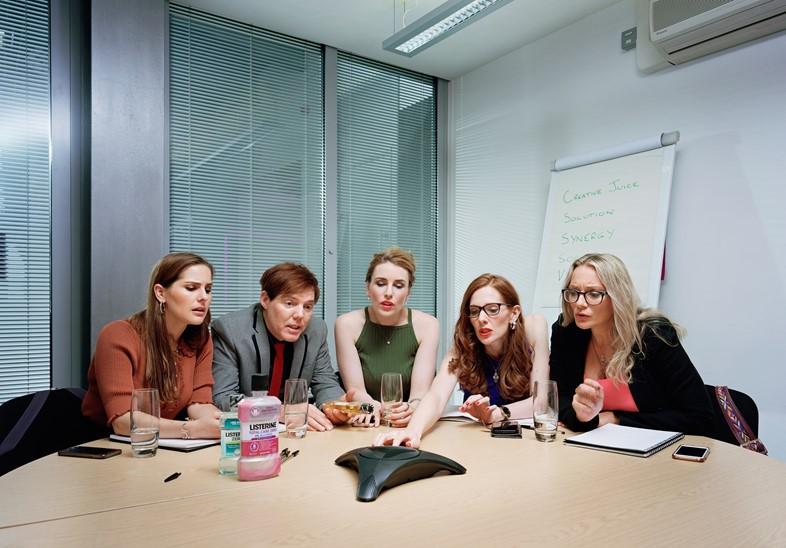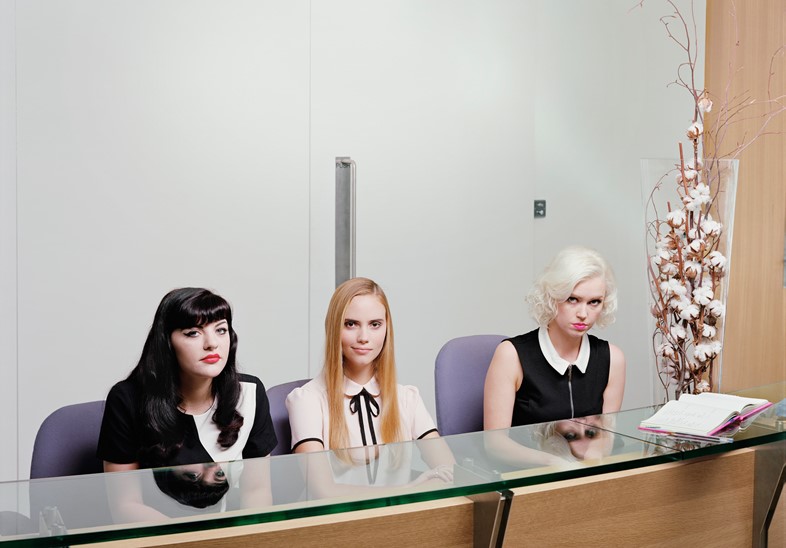David Stewart’s new body of work is an unflinching take on the world of advertising today
When David Stewart started shooting commercial advertising campaigns in the 1980s, the process would begin with art directors faxing over their drawings. Ideas were left to percolate. There was room for interpretation and spontaneity. Today he’s more likely to receive a low-resolution stock image as the place to start. “Invariably, you find yourself being told that something doesn’t look like something else,” he says. Originality is out.
Paid Content – his new body of work – takes a wry look at the characters, conversations and competition lurking within the walls of advertising. Places where concepts are chewed over in glass meeting rooms, the tables scattered with unripe fruit, individually wrapped muffins, eco-conscious water vessels, wires and totemic urns of thin coffee. “Agencies have become so much more corporate,” Stewart says. “The art buyers have been replaced by the producers who are more concerned with time and money than the art. Projects are broken into a thousand pieces. Every little thing is pored over and considered and that disrupts the whole creative process. It can squeeze the fun out of it.”

Born in Lancaster, Stewart moved to London after graduating from Blackpool and The Fylde College in 1981. Two years ago he was presented with The Royal Photographic Society award for outstanding achievement and excellence in the fields of editorial, advertising and fashion photography. His pictures display great humour, compassion and observation. For Paid Content, Stewart asked actors to perform scenes taken from real-life experiences – images released simultaneously as an exhibition at Wren London and as a glossy soft-cover book published by Browns Editions. The pages have the smooth, sickly snap of a fashion magazine’s September issue, but large wedges of dazzling blank paper are stacked at the front and back. “We’ve removed all the space usually taken up by adverts, right down to the back cover. The title you’ll find hidden in a sea of white on page seven,” Aaron Easterbook, creative director of Browns Editions says. “The white space is the counter blow, the sentiment being: it doesn’t have to be this way.”
The digital revolution of the last 20 years hasn’t just changed how pictures are commissioned and consumed, but also how they’re constructed. Stewart used to shoot a Polaroid on set – its size alone dictated how people would examine it, with intimacy, intensity. Today, a digital image flashes up onto a huge HD screen for everyone’s perusal. “Seeing it like that somehow emphasises all the wrong elements. People fixate on a sock or a scarf that isn’t straight, which, when you get to the final result, is completely irrelevant if the expression isn’t right.”

The fakery and camp of his tableaus nods to both Renaissance and Baroque paintings. His subjects are locked in business-casual dialogue, caught in the moment. “I once did a shoot of a face-off between a penguin and a man looking at a yoghurt,” Stewart recalls. “I was sat in a meeting having a serious discussion about it and the client asked, ‘what will the expression on the penguin’s face be?’ and you just think, what’s going on! It’s a penguin! ‘Don’t worry,’ I said, ‘It’ll definitely be smiling.’”

Paid Content runs from September 28 until November 17, 2018, at Wren London. The accompanying book is out now, published by Browns Editions.






